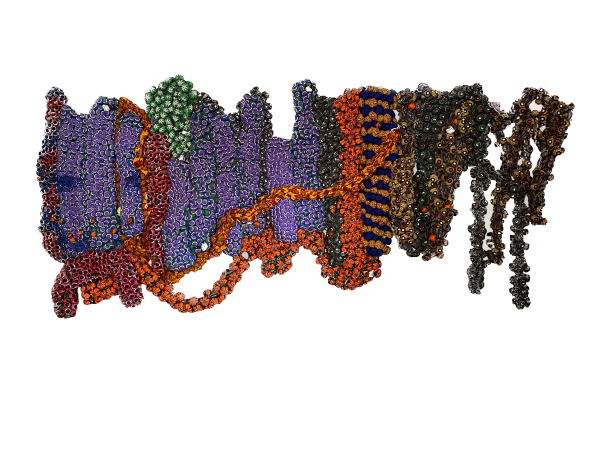-
Samuel Nnorom | What Tomorrow Holds
-
What Tomorrow Holds is a solo presentation of Samuel Nnorom’s latest body of work which explores the necessity of human connection.
Nnorom’s meticulously crafted tapestries speak powerfully on the importance of communities. His works are humanist expressions of connection, where individually rounded nodes of Dutch wax fabric and cotton thread are tightly woven into bright, undulating forms. These nodes are illustrative of human bonds, where individual forms merge into a collective whole.
His artworks stand as social portraits of town halls and imaginations of tomorrow, optimistic representations of human connectedness in contrast to our difficult world. The use of Dutch wax fabrics call to centuries of trade between Europe and Africa for this commodity, yet connect to the artist’s memories of colourful scraps in his mother’s tailoring workshop in Nigeria. Nnorom’s textile pieces point to his individual experience, national heritage while taking on continental formations, devoid of equators and provinces.
-
"Where we perceive a chain of events, he sees one single catastrophe which keeps piling wreckage and hurls it in front of his feet…[he] would like to stay, awaken the dead, and make whole what has been smashed…"
— ‘Theses on the Philosophy of History’, Walter Benjamin.
-
The Ankara material is ubiquitous — widely known as a fabric carrying complex and conflicting histories that draw attention to its origin and manufacturing in the West, against the grain of its import and use within many African countries. If ever there was such a thing as material culture, this would be it. The storied material - shipped and commodified across the globe - carries out the task of memory and revelation. But in that too, it is rendered mutable, held open at different levels.
In his solo exhibition, ‘What Tomorrow Holds’, Samuel Nnorom meditates on history through material, archive and process. Through his fabric-covered foam balls, Nnorom uncovers layers of time (its effect on material culture, community, and the environment). His tapestries carry the rich methods of crafting, making, living and communing in West Africa and by extension, other African countries with similar histories.
Inspired by the Igbo adage Onye Ma Echi meaning ‘Who Knows Tomorrow’ the exhibition title gestures to the precarity and unknowability of what lies ahead while reflecting on Igbo culture’s influence on Nnorom’s work. He says; “It encapsulates the idea of uncertainty. Life is unpredictable and filled with secrets and mysteries. My art explores the human condition within this uncertainty, using familiar materials to symbolize the facade we often wear to hide our true selves. Just as we cover our bodies, we also cover our world, creating a bubble of illusion. But deep within, there are truths we conceal, connecting us all in our shared vulnerability and resilience.”
For Nnorom, the idea of a ‘bubble’ is central to his work, conceptually and materially. As thin spheres enclosing air or other gasses to create boundaries, bubbles are a life force expressed in nature, human physiology and even the smallest particle of a chemical element that can exist, the atom. Bubbles can also allude to situations that isolate themselves from reality - they are illusionary, fantasies, castles in the air. It is this spherical form that Nnorom reaches for in his practice to speak to fragility and transience against permanence and rigidity. Nnorom sources materials from local markets and workshops, focusing on colours and textures that speak to him. The materials are stitched into bubble-like forms, with compositions that evolve organically in each work.
His approach to form makes visible the labour entailed in art making. Each tapestry reflects a labour-intensive process and highlights the relational coordinates and imbrications between trade, the ecology and collective histories of people through material. And time too — the experience of being in time, working through time and having time reveal itself to you. Each piece of fabric reveals what Walter Benjamin reflects on as “one single catastrophe which keeps piling wreckage”, that is to say, how history unfolds.
Fluidity is expressed in the work at multiple registers - thinking of the bubble as a porous and shifting phenomenon, for instance, and more tangibly, by allowing the soft sculptures to take on a different form every time they are hung. The work is flexible, allowing for (re)interpretation. This formulation conjoins two senses of permanence and impermanence that permeate the praxis of his art.
‘What Tomorrow Holds’ gives material a kind of criticality, reminding us of its capacity to hold more than one narrative at a time. It nudges us to consider the liquid nature of history through the malleability of fabric. Through the past, history is pushed back into the future, which remains uncertain and open. The bubbles contained in the work become metaphors for the uncertainties and precarious structures navigated in daily life. The tapestries are a kind of self-reflection that meditates on how our daily lives are connected and intertwined as threads in the communal fabric. Nnorom writes; ”As we stitch ourselves together we ponder the uncertainties of tomorrow while clinging to the hope that permeates through the fabric of our existence.”
—Nkgopoleng Moloi
-








